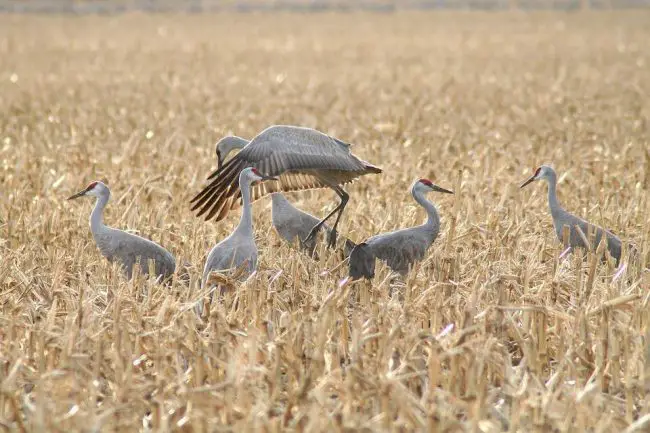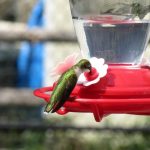Sandhill cranes are easily identifiable by their bright red foreheads, white cheeks, and long, black bills with pointed tips. During flying, their lengthy, black legs trail behind them, while their lengthy necks remain in a straight position. Birds that are still immature have upper parts that are reddish-brown and underparts that are grey. Both sexes have similar appearances.
They do, in fact, have beaks that are quite sharp and may pose a threat to a dog. Having said that, there shouldn’t be an issue as long as you exercise caution and ensure that you only allow your dog to recover dead birds.

Are Sandhill Cranes Aggressive?
There have been isolated reports of cranes attacking individuals with their beaks. Cranes have also been known to cause damage to window screens and other parts of buildings and property. This activity is likely the result of the birds seeing their own reflection, which triggers territorial defensive instincts in the birds, such as clawing against glossy autos or windows.
How do you scare off sandhill cranes?
Cranes are easily frightened, and can be driven away by placing scarecrows or black flags in the area that move in the wind. Move them every four to five days to a new location. It is possible to get satisfactory results by placing artificial predators such as snakes, alligators, or fish that jerk back when they are grabbed. This is particularly effective if the fake predators float around and appear to be alive.

What does it mean when a crane is in your yard?
“Having the opportunity to interact with a crane is a moving experience. You are being urged to search within yourself, to be fair to all people, and to safeguard your wisdom while yet imparting it in a manner befitting the situation. In a nutshell, you are being guided along the path that leads to harmony and good success.

How can one differentiate between male and female sandhill cranes?
Male Sandhill Cranes may weigh up to 14 pounds, which is around 2 pounds more than their female counterparts. The females typically weigh around 10 pounds. The height of the birds can reach up to five feet when they are standing on the ground, and this is measured from their toes to the top of their heads. In most cases, the male is a few centimeters (or inches) taller than the female.
Are the heads of both male and female sandhill cranes red?
The Sandhill Crane is a large species of bird. It features a lengthy neck and legs in addition to a bulky torso. Both the male and the female have the same general look, although the male is significantly bigger than the female. The adult’s body is grey, but the crown and lore’s have a dull red skin coloration.

What do you call baby sandhill cranes?
Due to the length and strength of their legs, young sandhill cranes are referred to as colts. Sandhill cranes are monogamous throughout their whole lives and produce two eggs that take around one month to hatch.

What do sandhill cranes eat?
Cranes of the Sandhills are omnivores, which means that their diet consists of both plant and animal stuff. Seeds, plant tubers, grains, berries, insects, earthworms, mice, snakes, lizards, frogs, and crayfish are some of their favorite things to eat. Other foods they consume include crayfish.

Where do sandhill cranes spend their nights?
The majority of crane species spend their nights resting upright on the ground. They often choose standing in water that is only a few centimeters deep, frequently on only one leg, and tucking their heads and necks on or under one of their shoulders. Cranes sleep in or in close proximity to their nests throughout the breeding season so that they can protect their young, whether they are eggs or chicks.
Are cranes afraid of humans?
Sandhill Cranes are not scared of people and will frequently get within a few feet of people who are watching them. It is imperative that you do not approach them too closely, not only to protect yourself from the remote possibility of an attack, but also to prevent the bird from growing accustomed to too much interaction with humans.
What is sandhill cranes’ prey?
Sandhill cranes get the majority of their nutrition from plant materials, but when food is low, they will consume virtually anything that can be digested. They dig and probe the ground with their bills in order to find seeds, berries, and other roots. They will also consume cultivated crops such as maize, cottonseed, and wheat, amongst other foods.
When are sandhill cranes most active during the day?
Sandhill cranes are diurnal, meaning they are active during the day; however, they spend the most of their time either sleeping, searching for food, or interacting with other species of birds. In the spring, they also spend around three months tending to their young.
Why does the beak of Sandhill cranes have a hole?
Due to the presence of these air sacs, the air that they breathe can only go in one way through their lungs. At the beginning of the inhaling process, air travels via the nares in the bird’s beak, through the windpipe (trachea), and finally into the air sacs located behind the bird (posterior or caudal air sacs).
What kinds of foods do sandhill cranes prefer to eat?
Cranes of the Sandhills are omnivores, which means that their diet consists of both plant and animal stuff. Seeds, plant tubers, grains, berries, insects, earthworms, mice, snakes, lizards, frogs, and crayfish are some of their favorite things to eat. Sandhill cranes, unlike other wading birds like herons, do not engage in the activity commonly referred to as “fishing.”
What do you call a group of sandhill cranes?
There are several collective nouns that may be used to refer to a group of cranes, such as a “construction,” “dance,” “sedge,” “siege,” and “swoop” of cranes.
When a sandhill crane’s mate dies, what can it do?
Sandhill cranes tend to pair throughout their whole lives. When a pair relationship is formed, it might persist for years or even until one of the cranes in the pair passes away. After the death of a mate, the remaining crane will search for a new partner to mate with. Sandhill cranes will begin courting and pairing off with potential mates in the early spring, while they are still travelling to their nesting grounds.
Do cranes fly during the night?
Sandhill cranes, in contrast to songbirds and ducks, migrate mostly during the daytime hours and only very seldom do so during the night.
Why do sandhill cranes jump?
Sandhill crane males go through an elaborate mating ritual in which they show possible mates how strong, powerful, and protective they can be. He prods sticks, reeds, or long grasses with his fingers and will occasionally fling them into the air. He flaps his wings, rattles his tail feathers, and does some sort of hopping motion with his body.
What should baby cranes eat?
Cranes are not picky eaters and will eat almost everything. This indicates that they consume virtually whatever they can get their hands on, with their diet changing according to the resources at their disposal at any given time. They will consume things such as tiny fish, rodents (such as mice and rats), amphibians (such as toads and frogs), insects, plants, and even berries.
Are sandhill cranes friendly?
Sandhill Cranes are not scared of people and will frequently get within a few feet of people who are watching them. It is imperative that you do not approach them too closely, not only to protect yourself from the remote possibility of an attack but also to prevent the bird from growing accustomed to too much interaction with humans.
Do cranes eat fish from ponds?
The great blue heron, which is also known as the blue crane, is a kind of predatory bird that likes to hang around in shallow ponds in order to capture fish and frogs for food. During this process, it is possible for it to transmit algae, illnesses, and even the eggs of fish to other bodies of water.
Where do sandhill cranes go during the winter?
The northern United States, Canada, Alaska, and Siberia are all breeding grounds for migratory subspecies of sandhill cranes. Long migrations to warmer climates in the south, including Florida, Texas, Utah, Mexico, and California, are typical of their yearly winter routines.
Are Sandhill Cranes and Turkey Hawks Equally Likely to Attack Dogs?
When evaluating the likelihood of sandhill cranes and turkey hawks attacking dogs, it is essential to focus on turkey hawks and their behavior towards dogs. While sandhill cranes generally pose minimal threat to canines, turkey hawks may exhibit more aggressive tendencies. It is important for dog owners to be aware of this distinction and take necessary precautions accordingly. Stay vigilant and prioritize your dog’s safety when encountering these birds.
How many years do cranes live?
Cranes that are kept as pets have been known to survive for up to 30 years. Many sandhills don’t make it through their first two years in the wild; but, if they do, they have a chance of living another 15–20 years after that.











